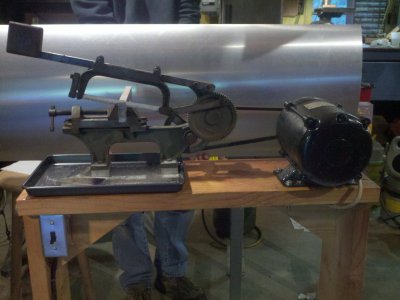Well, it's back together and working... and it sure is easier than cutting steel bars by hand! After cleaning it up and scotchbriting the rust, it really didn't need paint (except the motor), so a new wood base (with legs and wheels this time) and a tray to catch the chips, a valuable addition to my shop.

Only problem is the motor runs backwards according to the arrow on the gear. No doubt it's a simple wiring change inside the motor, but the motor was so corroded it's questionable whether I can get it apart. But it works pretty good as it is...
Quite the circular project, though. This power hacksaw project has been a distraction... lately my free time has been filled with woodworking projects, then found the saw last week at the junk shop... rusty but salvageable. Anyway, for my woodworking I found I needed a froe, a rather uncommon tool nowadays. I could buy a new one or search the flea markets, but for my particular projects I need one smaller than any I've ever heard of. Simple, make one now that I've got a mill, so I got some tool steel... but it'd sure be easier to cut it with the hacksaw, might as well fix that first, so I did... need a few spacers, sure would be easier to cut those spacers on the power hacksaw, but I need the spacers to run the saw, oh well, still have the hand saw... finally got the power saw done, cut the tool steel with it, back to the mill to make the froe, to continue the woodworking project...




